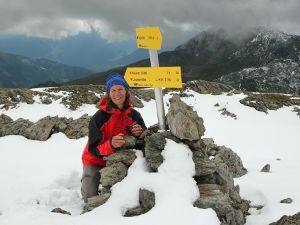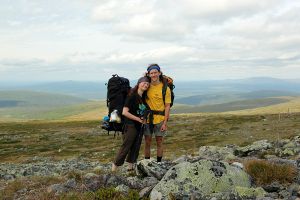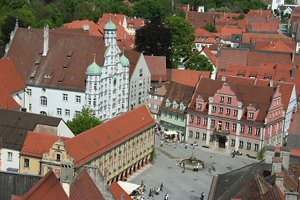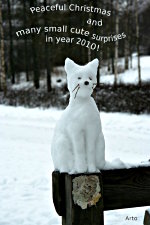Arto's Blog
Pages: << 1 ... 5 6 7 ...8 ...9 10 11 ...12 ...13 14 15 ... 27 >>
On the München-Venedig trail, part 1: The Austrian Alps
Posted: 2010-09-27 17:39:21, Categories: Travel, Austria, Italy, Hiking, 621 words (permalink)
 One of
Sandra's dreams was to go for a long walk one day. Like her, I had
been on many short hiking trips, lasting up to one week, but never
longer than that. So we decided to spend four weeks of our summer
holiday by walking over the Alps.
One of
Sandra's dreams was to go for a long walk one day. Like her, I had
been on many short hiking trips, lasting up to one week, but never
longer than that. So we decided to spend four weeks of our summer
holiday by walking over the Alps.
Our route was mostly following the München-Venedig trail, a 550 km hiking route from Munich, Germany to Venice, Italy. Apparently a few hundred people walk at least a part of the trail every year. The route is described with minor differences in at least three books, all in German. We were carrying two of them with us.
We skipped the first 150 km and started near Innsbruck in Austria. The first day was easy: a bus to Tulfes and a ski lift up to 2000 meters left only a few kilometers of distance and 600 meters of altitude to climb up to Glungezer hut, our first place to stay. This time we didn't carry a tent, but our backpacks were loaded with a camping cooker, food, clothes and other equipment needed for the trip.
Second day showed us the reality of the mountains: sunshine had turned into snow and clouds with almost zero visibility. We chose a route which stayed most of the time on a ridge above 2500 m, trusting the forecast which suggested weather to clear up by noon. Well, it didn't and we spent a full day doing our best to find safe steps on the slippery rocks. It was almost dark when we arrived at the next hut.
On the following day the weather was better again and we got used to the already familiar Alpine scenery: snow-capped peaks, rocky ridges, mountain lakes and grass-covered highlands where cows and sheep were grazing between the mountain flowers. A new companion we hadn't so often seen before were marmots, who were squeaking and standing on two feet besides their holes, looking at us.
The trail never climbed over 3000 meters but rarely descended below 1500 meters. The weather varied rapidly from 25°C sunshine to cold rain, with temperature occasionally falling down to 0°C and rain turning into sleet. Once we had to change our planned route: Friesenbergscharte was not passable due to too much snow and clouds. We hiked about 10 km west and crossed the ridge at Alpeinerscharte, knee deep in the fresh snow. On the way we stayed one night at Geraerhütte, which turned out to be one of the most charming huts of the whole trip.
I had usually traveled with a tent so hiking from hut to hut was something new for me. Huts in the Alps are quite well equipped, even luxurious: most have nowadays electricity, hot showers, water closets and a fully equipped restaurant. Perhaps a bit surprisingly, they are still considerably cheaper than hotels and guesthouses in the valleys, at least for Alpine club members. A bed in the dormitory costs 8-10 euros for members (about double from non-members) and meal prices are similar to simple restaurants down in the valleys.
Where the huts differ between each other is the atmosphere. Some are friendly and cozy family businesses where the hosts have time to talk with every guest personally, while others are more busy hostel and restaurant establishments. Small huts far away from roads and cable cars are usually the best. Our favourites on this hike were Geraerhütte (Austria), Kreuzwiesen Alm (Italy) and Rifugio Pisciadu (Italy).
Actually we were in Austria only the first five days before arriving in Italy. However, the main local language was German still for a week and both the mountains and architecture of houses remained similar to Austria. It took a few more days to reach the Dolomites, which looked quite different. More about them in part 2.
Hetta-Pallas-Ylläs trail: Peaceful felltops and mosquito-filled valleys
Posted: 2010-07-25 02:32:08, Categories: Travel, Finland, Hiking, 948 words (permalink)  During the first week of July Sandra and I did a one week hike in the Pallas-Yllästunturi national park. We enjoyed peaceful, broad views while walking on the higher fells and beautiful mysterious looking trees on the lower peaks. Valleys in between were lush and full of flowers, but well defended by the Finnish air force: clouds of mosquitoes.
During the first week of July Sandra and I did a one week hike in the Pallas-Yllästunturi national park. We enjoyed peaceful, broad views while walking on the higher fells and beautiful mysterious looking trees on the lower peaks. Valleys in between were lush and full of flowers, but well defended by the Finnish air force: clouds of mosquitoes.
The Hetta-Pallas trail is the oldest marked hiking trail in Finland and therefore easy to access by public transport. A night train from Helsinki carried us to Rovaniemi, from where we continued by bus to Hetta. A local shopkeeper was already waiting to take us over the Ounasjärvi lake to the point where the trail started.
On the first evening we had a short walk through forest to the Pyhäkero wilderness hut. To our surprise there was nobody else so we had the whole place for just the two of us. We cooked rice and vegetables for dinner and watched how the late evening sun was casting a warm orange glow on the buildings and trees. Then we laid out our sleeping bags and were looking forwards to a quiet night after a long day of traveling.
Bzzzt. Whack. Bzzzzzzt. There weren't a large number of mosquitoes around but enough to make it difficult to sleep. We were not sure if they were coming through the chimney, narrow holes around the door or somewhere else. Nevertheless, every time we thought we'd got rid of them a few more appeared. A lesson learned for the following nights: cook in the huts but set up the tent outside to have a good rest. An alternative would be to carry a mosquito net and use it inside the huts.
After Pyhäkero the trail climbed above the treeline and a light wind kept most of the insects away. It was cloudy but we saw dozens of kilometers in every direction over the fells, forests and lakes in the mostly uninhabited land. The most common sound was "beep", which a bird called kapustarinta (in Finnish) was singing while sharing the trail with us.
Hannukero is almost exactly half way on the 55 km trail from Hetta to Pallas and therefore the most popular place to stop. It was almost like a small village with several buildings, including both a free and reservation hut (pay in advance to get a key) with two rooms each, toilets, wood storage, fire places and even a sauna. The place looked like being designed for a hundred hikers but this time there were less than ten. The sauna was great, first time for both of us to enjoy a sauna in the middle of a hike. We stayed awake long enough to see the midnight sun before going to sleep — this time in our tent.
In early morning we first thought it was raining. That seemed odd because the sun was shining at the same time. A quick look outside solved the puzzle: the sound wasn't coming from the rain drops but instead hundreds of mosquitoes flying back and forth between the inner and outer tent. However, they didn't get inside so we quickly got used to the sound and it didn't bother us any more.
The section between Hannukuru and Pallas nature center went over the highest fells of the region, rising to about 800 m of altitude. The scenery showed its best when approaching Taivaskero, the highest point. The peak itself was too large and flat to have a great view towards any direction.
The popular part of the trail ended at the Pallas hotel and nature center. Popular in this case meant that we saw perhaps 50 people in total during three days. Summer was clearly not high season: most visitors come either in early autumn, or in late March or April which are the best months for cross country skiing.
We continued hiking still further towards Ylläs which is at the southern end of the park. The trail became smaller, more forested and less traveled: we met only two other hikers in three days. There were less open views but many interesting small details: gorgeous old spruces and twisted birches, wild orchids and cute, cozy wilderness huts waiting for the occasional wanderer. Our favourite was the "porokämppä" Mustavaara hut, which also reindeer herders are still using. Quite many birches were broken at a height of 1-1.5 meters and it seemed to have happened fairly recently. We were wondering if it was due to unusual snow conditions last winter or some other weather phenomena.
The air force became stronger during the Pallas-Ylläs part of the trail. Sun brought horseflies out and shades were well populated with mosquitoes. A cap with mosquito net, clothes and a bit of repellent kept most of them away but always a few found their way through. I didn't mind too much but it was difficult for Sandra whose skin was reacting more strongly on the bites than mine. In a way we were lucky of not having any midges, tiny flies whose bites are more painful than regular mosquito stings. However, the sheer number of mosquitoes made it impossible to sit outdoors and enjoy relaxing breaks except in places with enough wind.
We decided to end our hike at Äkässaivo lake about 15 km north of Ylläs. My aunt Pirkko came to pick us up and we enjoyed sauna at her home in Kolari, 40 km further south. It was actually already second time this year we visited her: we had been also cross country skiing in the Ylläs area just before Easter. After one and a half days and several delicious meals cooked by her we took a train back south to sunny, hot Helsinki.
Moving to Memmingen
Posted: 2010-06-26 14:56:59, Categories: Travel, Finland, Germany, 337 words (permalink)
 At the end of July I will be moving to Memmingen, Germany to live
together with
my girlfriend Sandra.
I'm planning to stay there until the end of the
year and after that we'll see what to do.
At the end of July I will be moving to Memmingen, Germany to live
together with
my girlfriend Sandra.
I'm planning to stay there until the end of the
year and after that we'll see what to do.
Memmingen is a town of about 40000 inhabitants in Bavaria, Southern Germany. It's the smallest place where I've lived this far in my life - all the others were cities with at least a few hundred thousand inhabitants. The closest big city is Munich about 100 km to the east. The Alps in the south are only about 60 km away which is great for hiking.
More important change than the location is that this will be the first time for me to live together with a partner. I've shared rooms and apartments with other students during my student years, but this is of course different. We've been meeting each other for more than a year now but I'm curious to see how the relationship will change when we'll be living under the same roof.
Renting out my apartment in Helsinki was surprisingly easy. I posted an announcement on a web forum and one hour later an old friend of mine answered that he needs temporary housing for his small family because their apartment will have pipe renovation. That's a good deal for both of us: I can leave most of my stuff inside and they can move into an apartment which is already furnished and has all kitchenware + other stuff needed for daily living in place.
I've been discussing with my employer about possibilities of working remotely from Germany. At the time of writing this it's still unsure whether it'll work out but I'm not too worried about it. Whatever the end result will be I'm sure it'll have more good than bad sides in it.
I will probably write more about my life in Memmingen in the autumn. However, before that I will have summer holidays, including a sailing trip, Rainbow Gathering in Finland, hiking and some cycling as well.
Winter camping in Helsinki archipelago
Posted: 2010-02-27 10:18:30, Categories: Travel, Finland, Helsinki, 557 words (permalink)
 We've had a beautiful winter in Helsinki this year. Lots of snow
everywhere, trees covered in frost, icicles hanging from buildings,
ski tracks on the frozen sea leading to nearby islands. The photo on
the right is from a weekend camping trip and I compiled a Winter 2010 in Helsinki photo gallery.
We've had a beautiful winter in Helsinki this year. Lots of snow
everywhere, trees covered in frost, icicles hanging from buildings,
ski tracks on the frozen sea leading to nearby islands. The photo on
the right is from a weekend camping trip and I compiled a Winter 2010 in Helsinki photo gallery.
The ground got covered by snow already in December and temperature has stayed below zero continously for two months now. In the city snow tends to get dirty but almost every week we've seen new, fresh, lightweight snowflakes falling down and making everything white again. Some people are complaining it's already too much but I think it has been an amazing winter.
Streets are lined with snow walls and some parking places have been converted to more than two meter high piles of snow. Cycling to work has been tricky and required extra time on some mornings, but usually by afternoon also the main bikeways have been cleared already. Smaller streets have seen snow tractors less regularly, but overall the city street maintenance has done a good job. Perhaps a little surprisingly, railways have had the biggest difficulties to cope with the snow: many trains have been cancelled and others have been late.
Sandra was here for one week and brought also her skis so we could go cross-country skiing together. We packed our backpacks full of warm clothes and food and headed out on the sea. After crossing Laajalahti bay from Munkkiniemi to Lauttasaari we continued about one kilometer further south to Käärmeluodot, a group of three small uninhabited islands which belong to the city of Helsinki. There's no regular ferry route even in the summer so the islands are only accessible by canoe or small boat. Camping is allowed.
I had actually never been on Käärmeluodot, but I knew from the outdoor map that there would be some basic facilities. Two of the islands had a cooking shelter and one of them was in use also during winter time, with free firewood provided by the city. A couple of other skiers were having a break and there was even a fire ready when we arrived.
However, it didn't take long until we were alone — only 5 km from city center and 1 km from densely populated Lauttasaari — but far away from city life. We cooked salmon and potatoes on the fire for dinner and set up our tent nearby. Later at night the wind became stronger and it started snowing again. The city disappeared behind a white wall and it felt almost like being in the wilderness. Our tent was well secured so we didn't have anything to worry about. I have winter pegs which are designed to hold the tent stable in the snow — the tiny summer pegs which normally come with tents are good for summer but useless in winter conditions.
On the following day we had breakfast and skied back. Part of the way it wasn't really skiing but rather walking with skis through the new snow. This time we took a different route towards Lehtisaari. There was some water on the ice near the shore and we had to make a small detour to avoid getting our feet wet. After that we felt we'd had enough exercise and took a bus for the last five kilometers home.
Season's Greetings
Posted: 2009-12-23 16:04:42, Categories: General, Helsinki, Art, 162 words (permalink)
 Last January, somebody had made a snow cat in the Helsinki central
park. There it was sitting quietly on a wooden plank, smiling and
looking at people passing by. I'm sure many of them smiled back and
became just a bit happier because of the cat.
Last January, somebody had made a snow cat in the Helsinki central
park. There it was sitting quietly on a wooden plank, smiling and
looking at people passing by. I'm sure many of them smiled back and
became just a bit happier because of the cat.
During these days a large part of the world is celebrating Christmas, either as a religious event, a family gathering, a materialistic festival or all three of them. In Finland where I live it is common to go shopping for gifts and even feel stressed about finding the right gifts for right people. I admit that I did some Christmas shopping too. However, the snow cat reminds me that a gift can be anonymous, it doesn't require buying anything, it can be given at any time of the year and that small surprises in life are often the best gifts.
With the cat, I wish all of you peaceful Christmas and many small surprises for year 2010!

Copyright Arto Teräs <ajt@iki.fi>, licensed under the Creative Commons Attribution-Share Alike 3.0 Unported License. (Unless otherwise mentioned in individual photos or other content.)